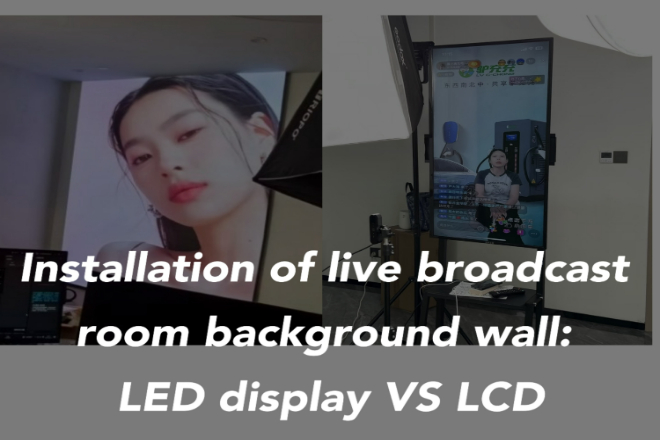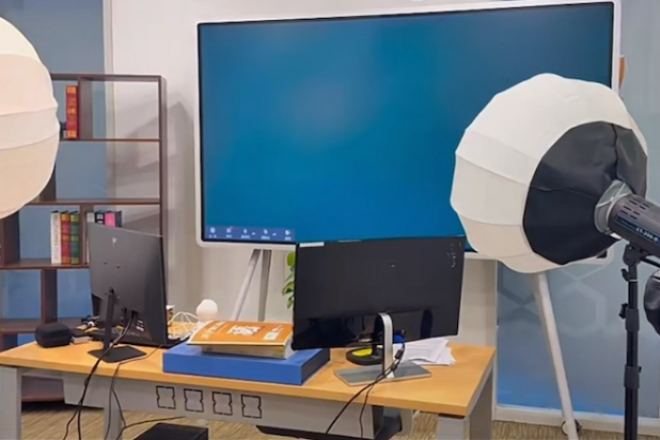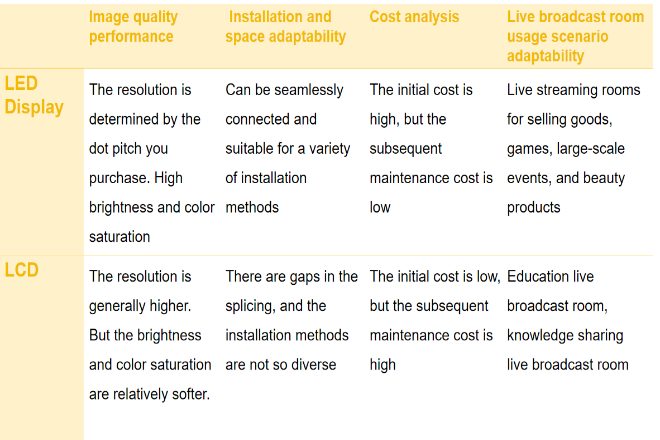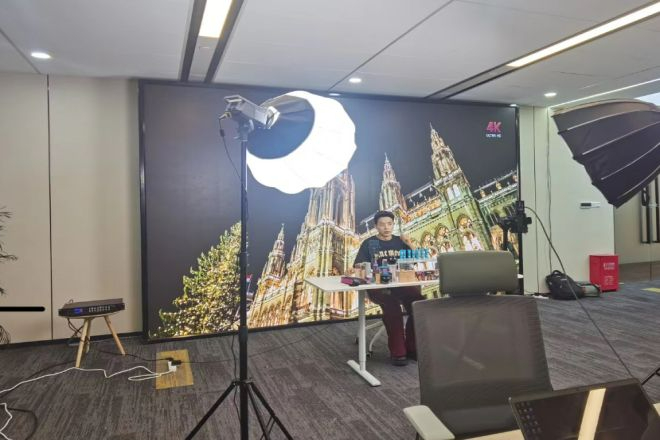소개

The rapid development of the live broadcast industry has led to the participation of many industries, such as the training industry, the beauty industry, and so on.
But whether it is knowledge sharing or entertainment interaction, having an excellent live broadcast room background wall can improve the quality and immersion of the live broadcast room several times.
However, facing the two mainstream display technologies on the market LED 디스플레이 and LCD screen, many practitioners are in a dilemma of choice: which solution is more suitable for their live broadcast room?
1. Basic knowledge of LED display and LCD

1). LED display
LED display, to put it bluntly, is a bunch of light-emitting diodes (LEDs) put together. Each LED is a small light point. These light points are arranged according to certain spacing and specifications to form the pixels we see.
By controlling the brightness and color of each LED, just like playing a puzzle, you can piece together various images and texts. Moreover, the working principle of the LED display is very smart.
It uses PWM (pulse width modulation) technology, which is to quickly switch on and off the LED lights so that our eyes feel that the brightness is changing so that different pictures can be displayed.
There are many kinds of LED display screens, such as:
The pixel pitch of this display screen is very small, generally less than 2 mm. You can’t see a single LED clearly even if you look closely. The picture is super clear and is especially suitable for indoor use, such as conference rooms and TV stations.
The pixel pitch is larger, and it can be used indoors and outdoors. It can be seen on billboards and stadiums.
This is the coolest. It can be bent and curved. You can make any shape you want. The creativity is endless!
The advantages of LED display screens are many:
높은 명도: It is dazzlingly bright. It is not afraid of sunlight when used outdoors, and it is also very bright when used indoors.
Seamless splicing: You can make it as big as you want, without gaps in the middle, and the picture is coherent.
Customizable size: You can make it as big as you want, which is very flexible.
Easy to connect to a computer: It can be used when connected to a computer, and it is convenient to display various information.
에너지 절약 및 환경 보호: It consumes less electricity and is environmentally friendly. It is green technology!
높은 신뢰성: It is not afraid of heat, cold, or humidity and can be used in any environment.
Of course, LED displays also have shortcomings:
Graininess at close range: 만약 픽셀 피치 is large, you can see small light spots when you look closely, which is a bit like a mosaic.
High initial cost: In comparison, LED displays are more expensive when they are first purchased, especially those with small pitch and flexible ones.

2). LCD display
LCD display is a liquid crystal display. It has two pieces of glass with liquid crystal in the middle. By applying voltage to the liquid crystal, the arrangement of the liquid crystal can be changed to control the transmission of light.
In this way, the image can be displayed. In order to display color, LCD also uses red, green and blue filters, just like a palette, to adjust various colors.
There are also several types of LCD displays:
TN-LCD: This is the cheapest and has a fast response, but the viewing angle is small, the brightness is low, and the color is not very accurate.
VA-LCD: The viewing angle is large, the color is accurate, and it is suitable for viewing high-definition pictures.
IPS-LCD: The color, viewing angle, and response speed are all good, and it is used in professional applications.
The advantages of LCD displays are also many:
풍부한 색상: Bright colors, realistic images, and look very comfortable.
높은 resolution: Images and text are very clear, without graininess.
낮은 에너지 소비: Less electricity consumption, energy-saving, and environmentally friendly.
Light and thin: Thin, light, easy to carry and install.
Long life: It will not break after a long time of use and can withstand tossing.
However, LCD screens also have some minor disadvantages:
Low brightness: In places with strong sunlight outdoors, the screen may not be clearly visible.
Smear problem: If the refresh rate is not high, fast-moving pictures may be a little blurry, like dragging a tail.
In general, LED screens and LCD screens have their own advantages. LED screens have high brightness, can be assembled into large screens, and are highly customizable, suitable for outdoor and large displays.
LCD screens have good colors, high resolution, and low energy consumption, suitable for indoor and mobile devices. Which one to choose depends on your needs!
2. Key comparison dimensions of LED screens and LCDs

1). Image quality performance
1.1). 해결:
LCD is like a photo taken by a high-definition camera, with every detail presented vividly. Whether it is a product close-up, text information, or the host’s facial expressions and movements in the live broadcast room, they can all be seen clearly, which is particularly suitable for live broadcast rooms that need to display fine content.
The resolution of the LED depends on the dot pitch. Small-pitch LEDs can also achieve very high resolutions, and the picture is as delicate as LCD. When used in a live broadcast room, even if the audience is close to the screen, it is difficult to detect the graininess, providing an immersive viewing experience for the audience.
1.2). Brightness 대조:
LED is like a big light bulb, with extremely high brightness and strong contrast. In the live broadcast room, even if the light is brighter, the LED display can still maintain a clear picture without being disturbed by light, ensuring the display effect of the host and the product.
The brightness and contrast of LCD are relatively soft, which is more suitable for indoor environments. In the live broadcast room, if the light is properly controlled, the LCD display can also present a good picture effect. But if the light is too bright, you may need to increase the brightness to keep the picture clear.
1.3). Color saturation:
The color of the LED is particularly bright, just like a cartoon, full of dynamics. For live broadcasts such as live broadcasts of goods and games that require strong visual impact, LED displays are definitely the first choice, which can attract the audience’s attention and enhance the viewing experience.
The colors of LCD are more realistic and closer to the colors we see with our naked eyes. For live broadcasts such as beauty live broadcasts and education live broadcasts that require accurate color restoration, LCD is more suitable, which can ensure that the audience sees the most realistic color effects.
2). Installation and space adaptability
2.1). LED display:
The LED display is like a puzzle, which can be seamlessly spliced into any shape you want. In the live broadcast room, the appropriate size and shape of the LED display can be customized according to the size of the space and layout requirements to meet various creative needs.
Moreover, the installation of the LED display is also very flexible. It can be wall-mounted, hoisted, and even made into a curved or special-shaped display, adding more features to the live broadcast room.
2.2). LCD:
The LCD display is like a piece of small squares that need a frame to splice. In the live broadcast room, if the space is limited or the pursuit of a simple and generous style, the LCD display is a good choice. Although there are gaps in the joints, they will not affect the viewing effect at an appropriate viewing distance.
Moreover, the size and shape of LCD screens are relatively fixed, and the installation is simple and convenient, which is suitable for a live broadcast environment that can be quickly built.
3). Cost analysis
3.1). Initial investment:
LED screens are like luxury cars. They are much more expensive when you buy them at the beginning. Especially for small-pitch and flexible LED screens, the price is ridiculously high.
However, for live broadcast rooms that pursue high quality and high effects, the investment in LED screens is worthwhile, which can improve the overall grade and viewing experience of the live broadcast room.
LCD screens are like economical cars, with affordable prices and mature and stable technology. For live broadcast rooms with limited budgets or not particularly high requirements for display effects, LCD screens are a very cost-effective choice.
3.2). Long-term maintenance:
LED screens are like energy-saving lamps, with long life and low energy consumption. Under long-term use in the live broadcast room, the maintenance cost of LED screens is relatively low, which can save a lot of electricity and repair costs.
LCD screens are like ordinary light bulbs. After a long time of use, the backlight module may need to be replaced. Although the current LCD display technology is very mature, the aging problem of the backlight module is still difficult to avoid.
Therefore, under long-term use in the live broadcast room, the maintenance cost of the LCD display may be slightly higher.
4). Adaptation of the use scenarios of the live broadcast room
4.1). LED is suitable for the live broadcast room scene:
- Live broadcast with goods:
Live broadcast with goods requires dynamic backgrounds and cool effects to attract the audience’s attention. LED display screens can present various dynamic effects, such as flashing lights, flowing colors, etc., which attract the audience at a glance and increase the desire to buy.
- Game live broadcast:
Game live broadcast requires high brightness and high contrast images to display game scenes and characters. LED display screens can meet this demand, making the game screen more vivid and realistic and improving the audience’s viewing experience.
- Live broadcast of large-scale events:
Live broadcasts of large-scale events such as concerts and press conferences require seamless splicing, customizable size and shape display screens to create a shocking stage effect. LED display screens can meet this demand and make the live broadcast room more colorful.
- Beauty live broadcast:
Beauty live broadcast requires a display screen with realistic colors and clear details to show the effects of cosmetics. The color reproduction of LED display screen is relatively high, which can accurately show the color and texture of cosmetics, allowing viewers to see the most realistic makeup effects.
4.2). LCD is suitable for the live broadcast room scene:
- Educational live broadcasts:
Educational live broadcasts require static high-definition images to present text, pictures, and other information. LCD screens have a relatively high resolution and can clearly display the content of courseware, making it easier for students to understand and accept knowledge.
- Knowledge-sharing live broadcasts:
Knowledge-sharing live broadcasts such as lectures and courses require clear and stable images to present the lecturer’s explanations and demonstrations. LCD screens can meet this demand, allowing the audience to clearly see the lecturer’s movements and expressions, improving learning effects.
In general, LED and LCD have their own advantages. When choosing a live broadcast room, you should decide based on specific needs and budget.
If you pursue a dynamic, cool, high-brightness display effect and have sufficient budget, then LED screens are definitely the first choice.
If you pursue a realistic, delicate, and affordable display effect, or if your budget is limited, then LCD screens are a very good choice.
3. Tips for selecting the background wall of the live broadcast room

Choosing a background wall for a live broadcast room is not as simple as a board. It must match your live broadcast content, budget, venue, and your individual needs. Here are some detailed tips to help you find the most suitable background wall:
1). Determine the background wall according to the content of the live broadcast
1.1). Mainly dynamic content:
In this case, an LED display is definitely the first choice. It has high brightness and strong contrast.
The picture does not smear when it moves, and the colors are bright, making the audience feel as if they are in the scene. Especially for those scenes that require fast response and high-definition picture quality, an LED display can definitely hold it.
1.2). Mainly static display:
LCD display is quite suitable for this scene. It has high color reproduction and delicate pictures. It can accurately display the color and texture of the product or clearly present text, pictures, and other information.
Moreover, the price of LCD displays is relatively affordable, which is a good choice for live broadcast rooms with limited budgets.
2). Budget and venue should also be considered comprehensively
2.1). Adequate budget and long-term use:
If you have a sufficient budget and plan to use this live broadcast room for a long time, then a small-pitch LED display is a good choice.
It has good picture quality and lasts for a long time. Although the initial investment is larger, in the long run, the cost performance is still quite high. Moreover, the small-pitch LED display can be customized in size and shape according to the size of your venue to meet your personalized needs.
2.2). Tight budget or just temporary use:
If the budget is limited, or you are just temporarily building a live broadcast room, you can consider splicing several LCD displays together as the background wall. This is relatively low-cost and easy to install.
In addition, you can also combine green screen technology and use virtual backgrounds to enrich the live broadcast content, which can save costs and make the live broadcast more interesting.
3). Have special needs? Here are a few solutions
3.1). Want a combination of dynamic and static effects:
If you want both dynamic effects and static displays, you can consider using a combination of LED main screen + LCD auxiliary screen. The LED main screen is responsible for presenting dynamic images to attract the audience’s attention.
The LCD auxiliary screen is used to display static information or product details so that the audience can better understand your live broadcast content. This combination can not only meet your dynamic needs but also take into account static displays, and the effect is very good.
3.2). Want to reduce hardware dependence and have rich content:
If you want to reduce hardware investment and make the live broadcast content rich and diverse, you can consider combining virtual backgrounds with physical screens.
You can use green screen technology or virtual reality technology to combine virtual backgrounds with physical screens to create unique live broadcast effects.
This can not only reduce dependence on hardware but also provide diverse live broadcast content, making your live broadcast room more colorful.
In short, choosing a live broadcast room background wall requires comprehensive consideration of many factors, including live broadcast content, budget, venue, and individual needs.
Choosing the right background wall can not only improve the visual effect of the live broadcast and the audience’s viewing experience but also make your live broadcast room more colorful and attractive. I hope these tips can help you and make your live broadcast room more successful!
결론
Finally, through comparative analysis, it can be seen that there is no absolute difference between LED display screens and LCD screens – LED, with its dynamic expression and spatial adaptability, is more suitable for live broadcast rooms that pursue cool visual effects and large scene coverage.
LCD’s high-definition picture quality and high cost performance can provide stable support for scenes such as knowledge sharing and product detail display.
It is best to choose according to your needs.
마지막으로 LED 디스플레이에 대해 더 알고 싶으시다면, 우리에게 연락해주세요.
